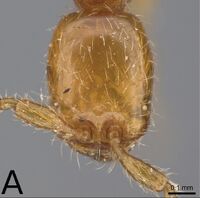Aenictus boltoni
| Aenictus boltoni | |
|---|---|

| |
| Scientific classification | |
| Kingdom: | Animalia |
| Phylum: | Arthropoda |
| Class: | Insecta |
| Order: | Hymenoptera |
| Family: | Formicidae |
| Subfamily: | Dorylinae |
| Genus: | Aenictus |
| Species group: | rotundatus |
| Species complex: | mariae |
| Species: | A. boltoni |
| Binomial name | |
| Aenictus boltoni Gomez, 2022 | |
Nothing is known about the biology of this species.
Identification
Gómez (2022) - A member of the mariae species complex in the Aenictus rotundatus species group. This species can be separated from the rest of the mariae complex species as dorsopropeum is mainly smooth (reticulated in Aenictus hitai) and does not present the lateropropodeal pubescence characteristic of Aenictus steindachneri.
Separation from A. mariae minors as in the following table.
| Postpetiolar shape | PPI | Metapropodeal suture | |
|---|---|---|---|
| A. boltoni | Low, semispherical | 113 [107–127] | Visible, both laterally and dorsally |
| A. mariae | High, subquadrate with straight parallel anterior and posterior sides | 138 [130–150] | Faint and not discernible in minors |
This species does not present a marked allometry (CSR 114) as the other three species (CSR 131 for A. mariae and >170 for A. hitai and A. steindachneri) and seems to have a smaller maximum size (HW < 0.42 against 0.52 for mariae or 0.69 for steindachneri), though this can be due to a lack of material as the four species have similar minimum sizes (HW> 0.28 for hitai and >0.36 for the rest).
Also, this species seems to be distributed in West Africa, while the other three inhabit Southern and Western Africa and their distribution don’t seem to overlap.
Keys including this Species
Distribution
Latitudinal Distribution Pattern
Latitudinal Range: 9° to 6°.
| North Temperate |
North Subtropical |
Tropical | South Subtropical |
South Temperate |
- Source: Gomez, 2022
Distribution based on Regional Taxon Lists
Afrotropical Region: Ghana, Ivory Coast, Nigeria (type locality).
Distribution based on AntMaps
Distribution based on AntWeb specimens
Check data from AntWeb
Countries Occupied
| Number of countries occupied by this species based on AntWiki Regional Taxon Lists. In general, fewer countries occupied indicates a narrower range, while more countries indicates a more widespread species. |

|
Estimated Abundance
| Relative abundance based on number of AntMaps records per species (this species within the purple bar). Fewer records (to the left) indicates a less abundant/encountered species while more records (to the right) indicates more abundant/encountered species. |

|
Biology
Castes
Known from the worker caste. Table of castes known for all Afrotropical Aenictus species.
Worker
Nomenclature
The following information is derived from Barry Bolton's Online Catalogue of the Ants of the World.
- boltoni. Aenictus boltoni Gómez, 2022: 49, figs. 32A-D, 33 (w.) NIGERIA.
- Type-material: holotype worker, 3 paratype workers.
- Type-locality: holotype Nigeria: Gambari (= Cocoa Research Institute of Nigeria), 14.viii.1969 (B. Bolton); paratypes with same data.
- Type-depository: BMNH.
- Distribution: Ghana, Ivory Coast, Nigeria.
Unless otherwise noted the text for the remainder of this section is reported from the publication that includes the original description.
Description
Worker
HL: 0.46 [0.43-0.49]; HW: 0.37 [0.35-0.40]; SL: 0.25 [0.22-0.27]; WL: 0.64 [0.57-0.71]; PL: 0.16 [0.14-0.17]; PH: 0.11 [0.10-0.13]; PPL: 0.12 [0.11- 0.14]; PPH: 0.11 [0.10-0.13]; CS: 0.42 [0.39-0.44]; CI: 80 [75-82]; SIL: 53 [51-56]; SIW: 67 [63-71]; WL/HW: 171 [164-181]; PI: 138 [127-145]; PPI: 113 [107-127]; CSR: 114; (n=12).
Monomorphic. Scapes short, just reaching the median line of the head when laid back (SIL~0.49). Funicular segments wider than long, the subapical quadrate, apical two and a half times longer than wide. Head elongated (CI~79) with convex lateral sides and slightly widest at the middle; occipital line straight with rounded corners. Frontal carinae small, not surpassing the torulus and fused between the antennal sockets. Frontal ridges developed distally and projecting over the clypeus in frontal view. Long, sharp apical tooth followed by an 4–5 smaller denticles, sometimes very eroded. Clypeus reduced to a row of 5 small conical denticles below the antennal insertions and much smaller, almost invisible minute denticles laterally.
Propodeum and mesonotum weakly convex, propodeum flat; mesopropodeal suture clearly demarcated and visible both in lateral and dorsal views; mesonotum in dorsal view not forming a continuous surface with propodeum. Transverse mesopleural groove present. Mesometapleural suture present but very weak. Propodeal declivity flat; posterodorsal and posterolateral ridge absent.
Petiole sessile with anterolateral ridges present but very weak, anterodorsal, posterior and dorsolateral ridges absent. Petiolar dome low and rounded, subelliptical.
Postpetiole with anterior and posterior vertical faces and horizontal dorsal surface, antero and postero dorsal angles right and rounded. Subpetiolar process small, elliptical with a lamella varying in size from minute to clearly developed, facing anteriorly.
All body surfaces smooth and shining except for meso and metapleurae, petiole and postpetiole variable from alutaceus smooth in minima workers to the most common shagreenate- reticulated; dorsal surfaces of petiole and postpetiole from smooth to weakly shagreenate; mandibles shagreened. Overall colour light brown with some individuals yellowish brown.
Whole body except propodeal dorsum covered with short from erect to decumbent small white setae. Dorsum of propodeum bare except for its anterior and posterior borders. The length of the longer setae as petiolar height; setae on dorsal surface of head directed upwards; lateral sides of head with erect setae; scapes with scattered decumbent to semierect setae, shorter than scape width. No pubescence noted.
Type Material
- Holotype worker: NIGERIA: • Gambari 14/08/1969 (Bolton, B.) (1w) [NHMUK012849298] The Natural History Museum.
- Paratype workers: • same data, (2w each) [NHMUK012849294 to NHMUK012849297] The Natural History Museum; same data (1w) [NHMUK012849327] The Natural History Museum.
Etymology
The species name boltoni is Latinized noun in the genitive case, dedicated to Dr. Barry Bolton, who encouraged me to revise this genus and has always been extremely kind and helpful in my Afrotropical adventure.

